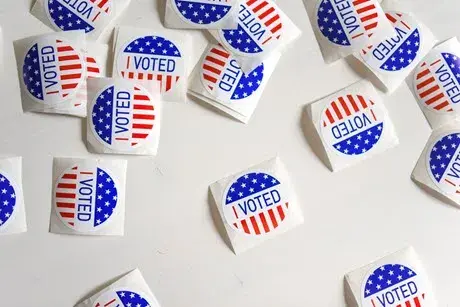What is the Electoral College?

Welcome to a US Presidential Election Year! Between now and November 3rd we will hear some words and phrases repeated over and over like “Electoral College” and “grassroots campaign” and “FiveThirtyEight.” Today we are going to take a look at the Electoral College and try to understand what all the talk is about!
For starters, “the Electoral College is a process, not a place.” It is a process established by Article II, Section 1, Clause 2 of the U.S. Constitution and modified by the 12th and 23rd Amendments. The process consists of three parts: the selection of the electors, the meeting of the electors, and the counting of the electoral votes.
Step 1: Selecting the Electors
The process by which the electors are chosen varies from state to state. “The U.S. Constitution does not specify procedures for the nomination of candidates for presidential elector. The two most common methods the states have adopted are nomination by state party convention and by state party committee.” For more information on the process of selecting electors, check out this NARA webpage.
Step 2: The Meeting of the Electors
On the first Monday after the second week in December, the electors meet in their home states. Most states require that all electoral votes go to the candidate who receives the most votes in that state. This is sometimes referred to as “winner take all.” Maine and Nebraska use something called the district system. he electors meet and cast their votes for President and Vice President on separate ballots. However, “there is no federal law or constitutional provision requiring electors to vote for the party that nominated them, and over the years a number of electors have voted against the instructions of the voters.” college.aspx) Electors who vote against the popular vote in their state are called faithless electors. “In 2016, there were seven faithless electors, the most since 1972—three Democratic electors from Washington state cast their votes for Republican Colin Powell, instead of Democrat Hillary Clinton; one Democratic elector from Washington state cast his vote for Faith Spotted Eagle, a woman who is a member of the Yankton Sioux Nation; one Democratic elector from Hawaii cast his vote for Bernie Sanders, instead of Hillary Clinton; one Republican elector from Texas cast his vote for John Kasich, instead of Donald Trump; and one Republican elector from Texas cast his vote for Libertarian Ron Paul.”
Step 3: The Counting of the Electoral Votes
The votes of the electors of each state are counted in a joint session of Congress. For more information about the process, check out this very detailed CRS Report called Counting Electoral Votes: An Overview of Procedures at the Joint Session, Including Objections by Members of Congress. C-SPAN even has a recording of the count from 1/6/2017. An example of what the ballot box looks like can be found here. For a fun fictional political thriller about the Electoral College see Roy Neel’s The Electors.
Now that we have covered the Electoral College, maybe we will discuss “grassroots campaign” and “FiveThirtyEight” in other blog posts!
Library Blog

